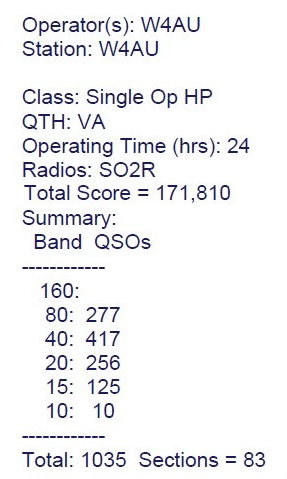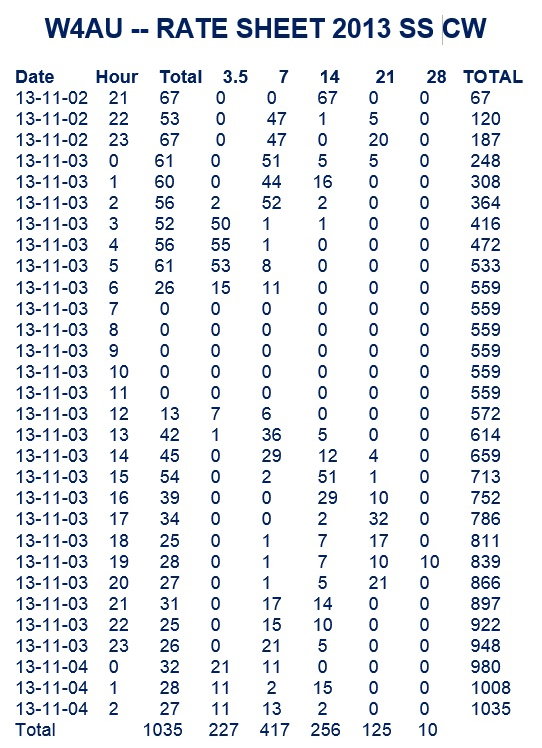Signals de Loudoun©
Stories of Amateur Radio In Loudoun County, Virginia
Volume 2013 Edition 2. Editted & Published By Norm Styer - AI2C de Clarkes Gap, Virginia
Here's A Very Special Report From One Our Supreme CW Operators
Stories of Amateur Radio In Loudoun County, Virginia
Volume 2013 Edition 2. Editted & Published By Norm Styer - AI2C de Clarkes Gap, Virginia
Here's A Very Special Report From One Our Supreme CW Operators
W4AU Story of 2013 ARRL CW Sweep Stakes
By John Unger, W4AU of Hamilton, Virginia
For the past few years I have always done a fair amount of preparation prior to the start of most contests but especially ARRL CW Sweep Stakes (SS). These chores are in addition to "normal" stuff like checking antenna SWR and amplifier settings, etc. I like to go through the last few years' logs and see what time and bands I worked some of the rarer, more distant sections, like NT, PAC, KP2, AK, etc. Then I also like to look at the rates sheets from these past SS's and try to see what bands I should be on and when to keep up good rates.
I began listening to the bands about 30 minutes before the start and found that 20 seemed to be in good shape for both long and intermediate paths, i.e, good coverage of high population areas. So I started out at the bell running on 14043 and stayed there with good rates until about 2145 when I went up to the top of the of the CW activity and started an aggressive S&P campaign down that band. About 2200 with 70 Q's logged, I moved to 40 and started S&P'ing until I found a clear run frequency at 7045. I moved down a few kHz to 7033 where I basically stayed for the next 5 hours running and picking up 53 additional second radio Q's on 15 and 20 for an average of 59 QSO's per hour. I worked KP4, KP2, and KL7 on 20 with the second radio while running on 40. About 0300 I went to 80 and first found a good run frequency high in the band and then an ideal location at 3535 where I stayed for the next 3 hours running and picking up 23 second radio contacts on 40. I had good rates on 80 and so had not much time for listening to other bands. I went to bed at 0640 with 566 QSO's, including dupes, in the log and needing ND, NE, VY1, and PAC for a sweep.
I was back in the chair at 1245 after ~6 hours of sleep, a shower, and breakfast. I messed around on 80 for a couple of minutes but soon QSY'ed to 40 where I did a quick S&P pass through the band before finding a nice run frequency higher in the band at 7053. I stayed there running for about 1 1/2 hours while picking up 17, 20 meter Q's on the second radio. When 40 seemed to be drying up, I moved to 20, where I found not only VY1EI but a clear'ish frequency at 14016, where I sat running hot and heavy for another 90 minutes not having time or ability to work more than 2 stations on 40 with the second radio. This run was to be the last with an hourly rate close to 60. I knew that the rest of Sunday would be slow, as usual, and that I would just have to stay in the chair and slug it out. I hadn't spent much time on 15 the first day, and listening on the second radio showed that band seemed to be long, but hot. So moved up there and worked a bunch of west coast stations plus PAC and ND! After some success on 15, at 1900 I thought I'd try 10 and picked up a few there on a band that seemed already to be fading. I went back to 15 for a while and then down to 20 mostly S&P'ing but having some short runs. Finally about 2130 I got back on my "money band", 40 meters. I found a decent run frequency, and not only that, but had NE call me for my 83rd section and a clean sweep!. I stayed on 40 until about 0000 running while working 15 stations on the second radio, at which point I went to the band where I feel the strongest in domestic contests, 80 meters. I basically stayed on 80 until the bitter end, trying to keep the rate up to at least 30 per hour while working the second radio hard for 24 Q's on 40 and 20.
I worked my last QSO at 0259. I had put 1043 Q's in the log, including 8 dupes, for a total of 1035 good contacts (if someone who's a dupe calls me when I am running, I just work them rather than try to explain things...). I used the second radio to work 134 of the total of 1035, so using SO2R really paid off for me this year. I have been trying SO2R for a number of years, now, and finally feel that I am beginning to get the hang of it. Of course, I feel very
I began listening to the bands about 30 minutes before the start and found that 20 seemed to be in good shape for both long and intermediate paths, i.e, good coverage of high population areas. So I started out at the bell running on 14043 and stayed there with good rates until about 2145 when I went up to the top of the of the CW activity and started an aggressive S&P campaign down that band. About 2200 with 70 Q's logged, I moved to 40 and started S&P'ing until I found a clear run frequency at 7045. I moved down a few kHz to 7033 where I basically stayed for the next 5 hours running and picking up 53 additional second radio Q's on 15 and 20 for an average of 59 QSO's per hour. I worked KP4, KP2, and KL7 on 20 with the second radio while running on 40. About 0300 I went to 80 and first found a good run frequency high in the band and then an ideal location at 3535 where I stayed for the next 3 hours running and picking up 23 second radio contacts on 40. I had good rates on 80 and so had not much time for listening to other bands. I went to bed at 0640 with 566 QSO's, including dupes, in the log and needing ND, NE, VY1, and PAC for a sweep.
I was back in the chair at 1245 after ~6 hours of sleep, a shower, and breakfast. I messed around on 80 for a couple of minutes but soon QSY'ed to 40 where I did a quick S&P pass through the band before finding a nice run frequency higher in the band at 7053. I stayed there running for about 1 1/2 hours while picking up 17, 20 meter Q's on the second radio. When 40 seemed to be drying up, I moved to 20, where I found not only VY1EI but a clear'ish frequency at 14016, where I sat running hot and heavy for another 90 minutes not having time or ability to work more than 2 stations on 40 with the second radio. This run was to be the last with an hourly rate close to 60. I knew that the rest of Sunday would be slow, as usual, and that I would just have to stay in the chair and slug it out. I hadn't spent much time on 15 the first day, and listening on the second radio showed that band seemed to be long, but hot. So moved up there and worked a bunch of west coast stations plus PAC and ND! After some success on 15, at 1900 I thought I'd try 10 and picked up a few there on a band that seemed already to be fading. I went back to 15 for a while and then down to 20 mostly S&P'ing but having some short runs. Finally about 2130 I got back on my "money band", 40 meters. I found a decent run frequency, and not only that, but had NE call me for my 83rd section and a clean sweep!. I stayed on 40 until about 0000 running while working 15 stations on the second radio, at which point I went to the band where I feel the strongest in domestic contests, 80 meters. I basically stayed on 80 until the bitter end, trying to keep the rate up to at least 30 per hour while working the second radio hard for 24 Q's on 40 and 20.
I worked my last QSO at 0259. I had put 1043 Q's in the log, including 8 dupes, for a total of 1035 good contacts (if someone who's a dupe calls me when I am running, I just work them rather than try to explain things...). I used the second radio to work 134 of the total of 1035, so using SO2R really paid off for me this year. I have been trying SO2R for a number of years, now, and finally feel that I am beginning to get the hang of it. Of course, I feel very


STATION DESCRIPTION:
Elecraft K3 with a P3, ICE 419 BP filter, and Ten-Tec Titan amp
Elecraft K3 with a ICE 419 BP filter and Alpha 78 amp
80 meter dipole at ~40'
40 meter extended double Zepp at ~45'
KT-34A triband Yagi at 45'
Using N1MM with a TopTen DX doubler SO2R box
Computer is a Lenovo Intel i5 pc with Windows 8
good about getting another unassisted clean sweep of all the ARRL and Canadian sections. The coffee from those mugs tastes especially good!
The N1MM logging program told me that I had operated 1438 minutes, out of the max of 1440, which is the most time I ever put in for SS. Of course, in addition to my big off time early Sunday morning I did take some 10 minute walks around the yard to stretch the kinks out and breath some fresh air. These didn't count for off time because they were less than 30 minutes.
I am pleased to report that Murphy did not visit the shack this year and that all the equipment and antennas worked perfectly. We had a couple of those inevitable "operator errors" when I was getting tired, but no serious consequences. I'm happy that I not only worked my three LARG friends, K0ZR, NC4S, and N4PD, but also, as I found out later, that they all had unassisted clean sweeps, too! Thanks for the Q's guys.
I am pleased to report that Murphy did not visit the shack this year and that all the equipment and antennas worked perfectly. We had a couple of those inevitable "operator errors" when I was getting tired, but no serious consequences. I'm happy that I not only worked my three LARG friends, K0ZR, NC4S, and N4PD, but also, as I found out later, that they all had unassisted clean sweeps, too! Thanks for the Q's guys.